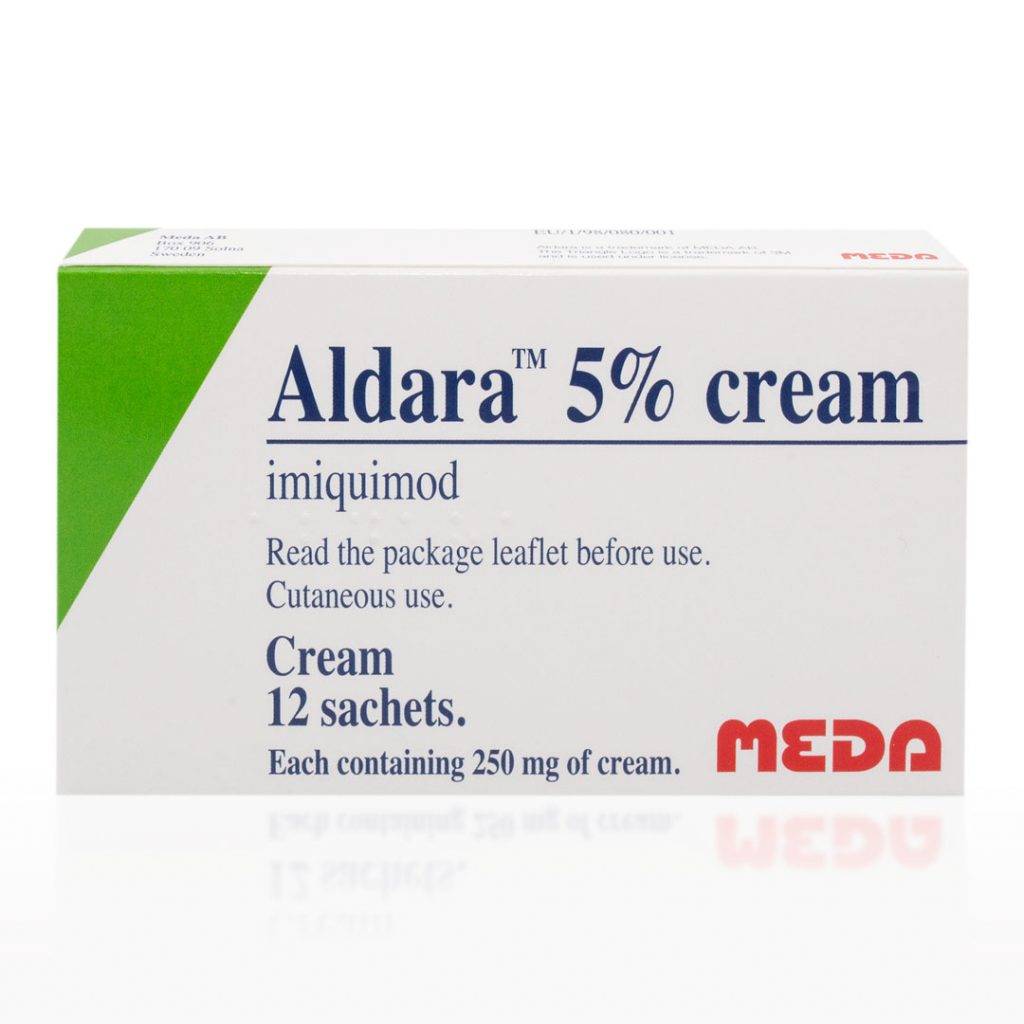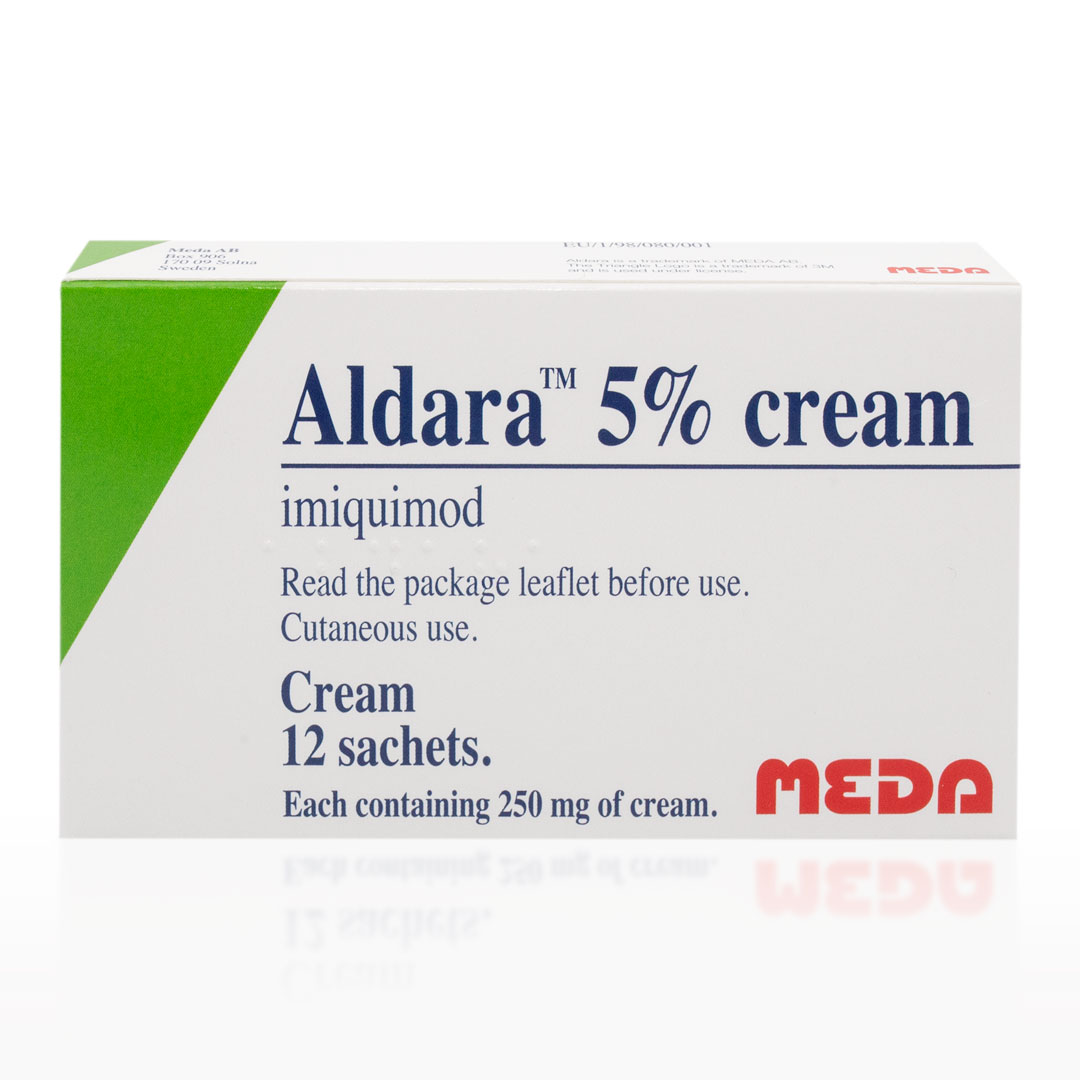Aldara (Imiquimod)
Aldara is a commonly used topical cream for the treatment of early skin cancers. In general, we only use it on the thinnest of skin cancers – Superficial Basal Cell Carcinoma (sBCC) and Squamous Cell Carcinoma in situ (SCCis) also known as Bowen’s disease.
We also can use it to treat pre cancer known as Actinic Keratosis (AK) however we tend to use efudix for this (5-fluorouracil) as the course is more convenient.
It is sometimes used off label for other harmless skin conditions like warts or molluscum.
How does it work?
Aldara activates “Toll-Like receptors” on skin cells. This basically super-activates the immune system in the skin, causing the natural defences in the skin (macrophages, natural killer cells and Langerhan cells) to either alert the immune system to the abnormal cells, or just kill those cells themselves.
Aldara should never be used in pregnancy, breastfeeding. It shouldn’t be used if you have immunosuppression, as the cream may be less effective.
How useful is Aldara?
In general, Aldara has a 70% chance of curing suitable skin cancers if used correctly. This compares to a 97%+ chance of cure if a mild cancer is surgically removed.
On the upside though you are usually not left with any scarring, and you also have none of the risks of surgery (including infection, damage to underlying structures like nerves or blood vessels, need for healing and rest after surgery).
How much Aldara should I use?
For treatment of most small superficial skin cancers, you really don’t need to use too much. A pea sized blob on the end of a gloved finger is usually more than enough – you use enough so that you can rub it into the skin.
At 10 minutes after application, you really shouldn’t be able to see any visible cream.
Don’t worry if you put slightly too much on, just use slightly less next time.
How bad is Aldara?
It depends on what it is being used for. It also depends on whether the cancer has been biopsied before treatment – often with biopsies we will remove the vast majority of the cancer, so there are far fewer abnormal cells for the body to attack and therefore a more mild reaction.
I generally find patients have a much more mild experience with Aldara than Efudix, but everyone is different, and it is always better to prepare for the worst!
How to use Aldara
I recommend applying Aldara 2-3 hours before bedtime. How long you use Aldara depends on your doctor’s advice and what you are treating. In general, I treat applicable skin cancers with Aldara once a day, 5 days a week, for 6 weeks. It doesn’t matter what 2 days off a week you have, but the easiest way to remember is not to put it on during weekends. We review the area 6 weeks after treatment has finished under dermoscopy to see if there is any evidence of remaining cancer.
Wash the skin with warm water. Do not use soap.
Pat the area dry, and then wait 10-15 minutes.
Apply Aldara to the lesion and the extra margin recommended by your doctor (usually 5 mm). Use a glove. You can use a cotton bud or Q-Tip, but I find you tend to waste more of the cream this way.
Avoid contact with mucous membranes – eyes, nostrils and lips. Talk to your doctor if the treatment area involves these.
Wash your hands thoroughly after application.
Do not cover the treatment area (e.g. with a dressing) unless your doctor has told you to. Covering the area with an occlusive dressing will increase the strength of the reaction and may increase the risk of side effects or toxicity. You may choose to cover the area (for cosmetic reasons) with a non-occlusive porous gauze dressing, which is unlikely to increase the reaction. You should discuss it with your doctor.
After 20 minutes, you can apply moisturisers, sunscreen and/or make-up as part of your usual skin care routine.
Aldara can take up to 2 hours to completely absorb into the skin – if you choose to use it in the evening, apply at least 2-3 hours before bedtime, so it doesn’t get rubbed off onto your pillow.
Do not treat an area larger than 5x5cm.
Side effects / Toxicity:
Aldara is usually a well tolerated medicine with minimal risks when used correctly.
Although I find Aldara is usually better tolerated than Efudix, many patients can be very red and sore. Depending on where you are receiving treatment, you may notice some swelling – for example, treating cancers on the side of the nose can often cause some puffiness under the eye. This is normal, but contact your treating doctor if you have any concerns.
Aldara should not be used in pregnancy or if you are trying for pregnancy or breastfeeding.
Temporary or Permanent Hyper or Hypopigmentation
Whenever the skin is inflamed (for whatever reason) there is always a chance of irritating the pigment cells – potentially causing permanent light or dark blotches. You can minimise this risk by correct application, and strictly avoiding sunlight during your treatment and for at least 6 weeks afterwards (you should be doing this anyway!)
If you already have facial pigmentation problems (e.g. Chloasma, Melasma) you may be at increased risk and should talk to your doctor.
Scarring
Any treatment that causes a lot of inflammation in the skin has a risk of scarring. Aldara is no exception to this. The risks of scarring with Aldara are low, but not zero.
In my experience, only a few patients have had scarring afterwards, and they have still preferred the small scar to a (much more obvious) surgical scar. Scars can also be treated with laser or other cosmetic treatments if needed.
Discuss this with your doctor prior to starting if you have any concerns
Worsening of rosacea or new telangiectasia
Sometimes the inflammation of the Aldara can increase the size of blood vessels in the skin, which can give facial skin a mottled or blushed appearance. We can use creams or laser to help this, but uncommonly this can be permanent and distressing for patients.
If you already have rosacea or red blotchiness of your facial skin, you should talk to your doctor about this and potentially consider other treatments if you are concerned about this risk.
Non-healing ulcer
This is mainly a problem with the lower leg. Because the blood supply isn’t very good on the lower leg, sometimes the wound caused by Aldara has trouble healing after the Aldara has finished.
Infections
In my experience as a skin doctor, it is very unusual for areas treated with Aldara to be truly infected by bacteria. It is much more common for patients or doctors without much experience to think the skin is infected because it looks horrible, particularly near the end of treatment – it is often a red, sore, oozing mess.
I have never needed to use antibiotics for an infection after Aldara. Sometimes, if there is any doubt, consideration can be given to topical antiseptics.
If you have any concerns, you should see a doctor familiar with Aldara straight away.


